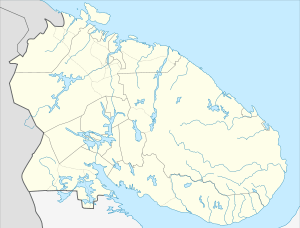Umba, Russia
| Umba (English) Умба (Russian) | |
|---|---|
| - Urban-type settlement - | |
|
| |
.svg.png) Location of Murmansk Oblast in Russia | |
 Umba | |
|
| |
_proposal.png) | |
|
| |
| Administrative status | |
| Country | Russia |
| Federal subject | Murmansk Oblast |
| Administrative district | Tersky District |
| Municipal status | |
| Municipal district | Tersky Municipal District |
| Urban settlement | Umba Urban Settlement |
| Statistics | |
| Population (2010 Census) | 5,532 inhabitants[1] |
| Time zone | MSK (UTC+03:00)[2] |
| Dialing code(s) | +7 81559 |
| Umba on WikiCommons | |

Umba (Russian: Умба) is an urban locality (an urban-type settlement) in Tersky District of Murmansk Oblast, Russia, located on the Kola Peninsula at the point where the Umba River flows into the Kandalaksha Gulf. Population: 5,532 (2010 Census);[1] 6,497 (2002 Census);[3] 8,309 (1989 Census).[4]
First mentioned in 1466, Umba, along with Varzuga, is the first documented permanent Russian settlement on the Kola Peninsula.[5] From the second half of the 15th century it served as the seat of Umbskaya Volost.
Transportation There is a bus from to Umba from Kandalaksha, going twice a day. The airport from Umba serves parts of the south endge of the Peninsula inaccessible by auto. Priority in buying tickets is given to locals, reserving them was not possible at least as of September 2013, and this mode of transportation cannot be considered reliable. A helicoper can be hired for around $3000 per hours (based on September 2013 information).
Politics and society Umba has been characterized by several sources as a quiet district managed by old-school Communists.
Foreigner travel Some of the coastline near Umba is off limits to foreigners. Ask local police for details. You can stay in Umba itself or travel along the road that goes along the sea from Kandalaksha to Varzuga though.
Culture, events, tourist information, travel services (taken from www.kandalaksha.su)
- Tourist Information Center, ul. Dzherzhinskogo 40, (881559) 51744.
- Folklore Festival three times a year
- Pomor Rawing Regatta, yearly
- Pomor Kuzulya (bread figurine) Festival at Kuzreka
- Sports Fishing Contest “Fish Face”
- Library of Pomor History and Culture, ul. Dzerzhinskogo 40, tel. 8 (81559) 51373.
- Museum of History, Culture, and Industry of Tersky Pomors, ul. Dzherzhinskogo 78, tel. 8 (81559) 51532, open Tue. to Sat. 9am to 5pm, closed Sunday and Monday.
- Kanozero Rock Carvings Museum, ul. Dzerzhinskogo 40, tel. 8 81559 50657, 8 911 312 9557, open Mon. to Thur. 8am to 5pm, close for lunch noon to 1pm, Friday 8am to 12noon, closed Saturday and Sunday.
- “Tonya Tetrina” fishing station. A history and ethnography complex. 27 km east from Umba (towards Varzuga). Tel. 8 911 343 5140.
- Umba Students Science Society.
- Amethyst Shore. Souvenirs, workshops. Ul. Gornaya 60, tel. 8 921 151 3991, 8 921 667 5920.
- Stuffed Fish Studio 8 921 152 1996
- Department of Preservation and Development of Pomor Traditions and Trades, ul. Belomorskaya 1a, tel. 8 815 59 52385. Open Tue. to Sat. 10am to 6pm (closed for lunch 2pm to 3pm), closed Sun. and Mon.
- Suvoy Tour Agency, the village of Kuzreka, tel. 8 81559 51135, 8 911 319 8973
References
- ↑ 1.0 1.1 Статистический сборник Численность, размещение и возрастно-половой состав населения Мурманской области. Итоги Всероссийской переписи населения. Том 1. 2012 / Федеральная служба государственной статистики, Территориальный орган Федеральной службы государственной статистики по Мурманской области. Мурманск, 2012 — 75 с.
- ↑ Правительство Российской Федерации. Федеральный закон №107-ФЗ от 3 июня 2011 г. «Об исчислении времени», в ред. Федерального закона №248-ФЗ от 21 июля 2014 г. «О внесении изменений в Федеральный закон "Об исчислении времени"». Вступил в силу по истечении шестидесяти дней после дня официального опубликования (6 августа 2011 г.). Опубликован: "Российская газета", №120, 6 июня 2011 г. (Government of the Russian Federation. Federal Law #107-FZ of June 31, 2011 On Calculating Time, as amended by the Federal Law #248-FZ of July 21, 2014 On Amending Federal Law "On Calculating Time". Effective as of after sixty days following the day of the official publication.).
- ↑ Russian Federal State Statistics Service (May 21, 2004). "Численность населения России, субъектов Российской Федерации в составе федеральных округов, районов, городских поселений, сельских населённых пунктов – районных центров и сельских населённых пунктов с населением 3 тысячи и более человек" [Population of Russia, Its Federal Districts, Federal Subjects, Districts, Urban Localities, Rural Localities—Administrative Centers, and Rural Localities with Population of Over 3,000] (XLS). Всероссийская перепись населения 2002 года [All-Russia Population Census of 2002] (in Russian). Retrieved August 9, 2014.
- ↑ Demoscope Weekly (1989). "Всесоюзная перепись населения 1989 г. Численность наличного населения союзных и автономных республик, автономных областей и округов, краёв, областей, районов, городских поселений и сёл-райцентров" [All Union Population Census of 1989: Present Population of Union and Autonomous Republics, Autonomous Oblasts and Okrugs, Krais, Oblasts, Districts, Urban Settlements, and Villages Serving as District Administrative Centers]. Всесоюзная перепись населения 1989 года[All-Union Population Census of 1989] (in Russian). Институт демографии Национального исследовательского университета: Высшая школа экономики [Institute of Demography at the National Research University: Higher School of Economics]. Retrieved August 9, 2014.
- ↑ Administrative-Territorial Divisions of Murmansk Oblast, p. 18
Sources
- Архивный отдел Администрации Мурманской области. Государственный Архив Мурманской области. (1995). Административно-территориальное деление Мурманской области (1920–1993 гг.). Справочник. Мурманск: Мурманское издательско-полиграфическое предприятие "Север".